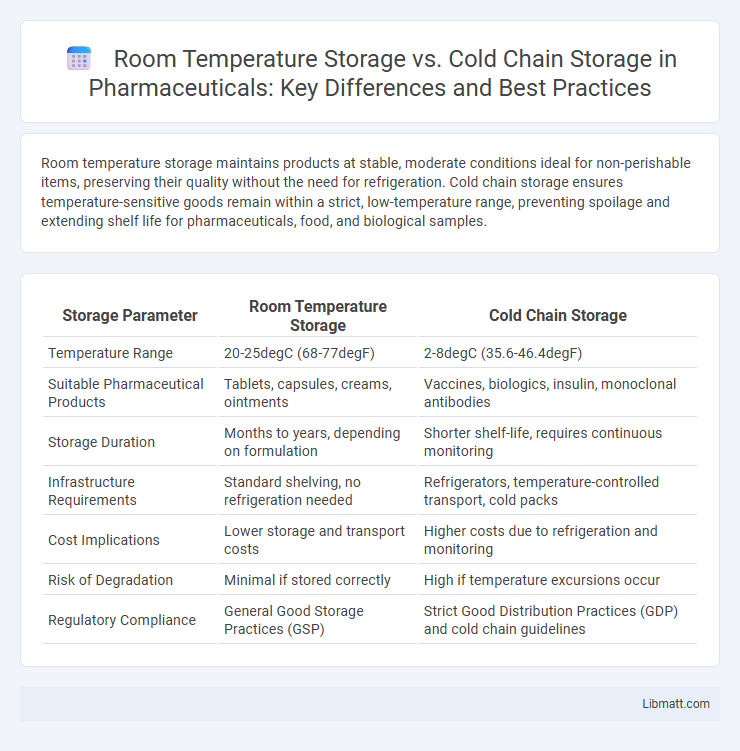Room temperature storage maintains products at stable, moderate conditions ideal for non-perishable items, preserving their quality without the need for refrigeration. Cold chain storage ensures temperature-sensitive goods remain within a strict, low-temperature range, preventing spoilage and extending shelf life for pharmaceuticals, food, and biological samples.
Table of Comparison
| Storage Parameter | Room Temperature Storage | Cold Chain Storage |
|---|---|---|
| Temperature Range | 20-25degC (68-77degF) | 2-8degC (35.6-46.4degF) |
| Suitable Pharmaceutical Products | Tablets, capsules, creams, ointments | Vaccines, biologics, insulin, monoclonal antibodies |
| Storage Duration | Months to years, depending on formulation | Shorter shelf-life, requires continuous monitoring |
| Infrastructure Requirements | Standard shelving, no refrigeration needed | Refrigerators, temperature-controlled transport, cold packs |
| Cost Implications | Lower storage and transport costs | Higher costs due to refrigeration and monitoring |
| Risk of Degradation | Minimal if stored correctly | High if temperature excursions occur |
| Regulatory Compliance | General Good Storage Practices (GSP) | Strict Good Distribution Practices (GDP) and cold chain guidelines |
Introduction to Storage Methods: Room Temperature vs Cold Chain
Room temperature storage maintains products at approximately 20-25degC, suitable for stable goods like certain pharmaceuticals and canned foods, ensuring cost-effective handling and simpler logistics. Cold chain storage requires controlled low temperatures, typically between 2-8degC or frozen conditions below -18degC, essential for preserving perishable items such as vaccines, biologics, and fresh produce by preventing spoilage and extending shelf life. Selecting the appropriate storage method depends on the specific temperature sensitivity and stability profile of the product to maintain efficacy and safety.
Understanding Room Temperature Storage
Room temperature storage typically ranges from 15degC to 25degC and is suitable for products that remain stable without refrigeration, such as certain pharmaceuticals and food items. This storage method reduces energy costs and simplifies logistics compared to cold chain storage, which requires maintaining temperatures between 2degC and 8degC or lower to preserve perishable goods. Proper understanding of product stability and moisture sensitivity is essential to ensure efficacy and safety in room temperature storage environments.
What is Cold Chain Storage?
Cold Chain Storage is a temperature-controlled supply chain process essential for preserving perishable products such as pharmaceuticals, vaccines, and fresh food by maintaining a consistent cold environment from production to delivery. This method ensures the efficacy and safety of temperature-sensitive items by preventing spoilage, degradation, and loss of potency caused by temperature fluctuations. Understanding Cold Chain Storage helps you safeguard product quality and comply with regulatory standards during transportation and storage.
Key Differences Between Room Temperature and Cold Chain Storage
Room temperature storage maintains products at approximately 20-25degC, suitable for pharmaceuticals and foods stable without refrigeration, while cold chain storage requires precise temperature control typically between 2-8degC or below to preserve temperature-sensitive items like vaccines and biologics. Key differences include the level of temperature control, risk of product degradation, and infrastructure requirements, where cold chain demands specialized refrigeration equipment, insulated packaging, and continuous monitoring systems. Cold chain storage mitigates microbial growth and chemical instability more effectively than room temperature conditions, ensuring product efficacy and safety in sensitive supply chains.
Advantages of Room Temperature Storage
Room temperature storage offers significant advantages including lower energy consumption, reduced operational costs, and simplified logistics without relying on refrigeration equipment. This storage method enhances product stability for temperature-resistant goods and minimizes the risk of cold chain breaches that can compromise quality. You benefit from increased flexibility in handling and transportation, making it ideal for many pharmaceutical, food, and chemical products.
Benefits of Cold Chain Storage
Cold chain storage ensures the preservation of temperature-sensitive products such as pharmaceuticals, vaccines, and perishable foods by maintaining consistent low temperatures throughout transportation and storage. This method significantly reduces the risk of spoilage, contamination, and loss of efficacy, thereby extending product shelf life and ensuring safety. Advanced cold chain logistics also support regulatory compliance and minimize financial losses due to product degradation.
Common Applications for Each Storage Method
Room temperature storage is commonly used for stable pharmaceuticals like tablets, capsules, and certain topical creams that do not require refrigeration, ensuring ease of access and reduced costs. Cold chain storage is essential for temperature-sensitive products such as vaccines, biologics, and some antibiotics, maintaining their efficacy from production to administration. Industries including food, pharmaceuticals, and biotechnology rely heavily on cold chain logistics to prevent spoilage and degradation of perishable goods.
Cost Implications: Room Temperature vs Cold Chain
Room temperature storage significantly reduces operational costs by eliminating the need for refrigerated equipment, energy consumption, and specialized packaging required in cold chain storage. Cold chain storage involves higher expenses due to continuous temperature monitoring, specialized transportation, and risk mitigation measures to ensure product integrity. Your choice impacts budget allocation, especially in industries like pharmaceuticals and food, where temperature control directly affects product quality and shelf life.
Impact on Product Shelf Life and Quality
Room temperature storage typically shortens product shelf life due to increased microbial growth and chemical degradation, impacting quality and safety. Cold chain storage maintains low temperatures, significantly extending shelf life by slowing down enzymatic reactions and microbial activity, thus preserving freshness, flavor, and nutritional value. Your choice between these methods directly influences product durability and quality retention during distribution and use.
Choosing the Right Storage Solution: Factors to Consider
Choosing the right storage solution depends on the nature of your products, their sensitivity to temperature fluctuations, and shelf life requirements. Room temperature storage suits items stable at 20-25degC, while cold chain storage is essential for temperature-sensitive goods requiring precise control between 2-8degC or lower. Evaluating factors like product stability, regulatory compliance, and cost implications ensures optimal preservation and safety for your inventory.
Room temperature storage vs Cold chain storage Infographic

 libmatt.com
libmatt.com